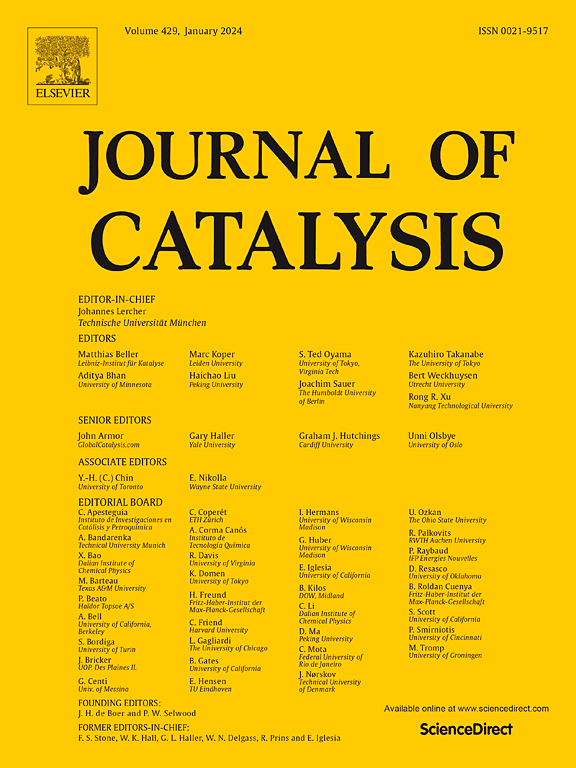揭示丁二烯单烷氧羰基化的机理:碱的作用是什么?
IF 6.5
1区 化学
Q2 CHEMISTRY, PHYSICAL
引用次数: 0
摘要
烯烃催化烷氧羰基化的机理已被广泛研究,普遍认为它经过三个基本步骤:(i)烯烃插入PdH键,(ii)羰基化和(iii)醇解。以[Pd(dtpx)H]+催化丁二烯甲氧羰基化反应为例,通过密度泛函理论(DFT)计算和核磁共振(NMR)鉴定出了一个高度稳定的Pd(η - 3-烯丙基)中间体。该中间体使该机制的表观动力学势垒与实验观察结果不一致(约200 kJ·mol−1)。结合DFT计算和实验分析,我们提出了一种基于“碱基辅助”途径的修正机制,其中二烯的单烷氧羰基化表现出显著降低的自由激活能(约100 kJ mol−1)。因此,我们提出来自Pd前体的碱是非无辜的,在醇解过程中作为质子穿梭体参与了反应。通过考虑不同的酸/碱对,我们进一步完善了这些发现,并证明酸和碱之间必须找到一个最佳的平衡,关于强度和浓度,以最大化催化活性。本文章由计算机程序翻译,如有差异,请以英文原文为准。


Unravelling the mechanism for the mono-alkoxycarbonylation of butadiene: what is the role of the base?
The mechanism of catalytic alkoxycarbonylation of alkenes has been extensively studied and it is generally accepted that it elapses through three elementary steps: (i) alkene insertion into a Pd![]() H bond, (ii) carbonylation, and (iii) alcoholysis. In the case of butadiene methoxycarbonylation catalyzed by [Pd(dtbpx)H]+, we have identified the formation of a highly stable Pd(η3-allyl) intermediate by Density Functional Theory (DFT) calculations and Nuclear Magnetic Resonance (NMR). This intermediate makes the apparent kinetic barrier of the mechanism incompatible with experimental observations (ca. 200 kJ·mol−1). Upon coupling DFT calculations and experimental analysis, we proposed a revised mechanism founded on a “base assisted” pathway where the mono-alkoxycarbonylation of dienes exhibits a significantly decreased free energy of activation (ca. 100 kJ mol−1). Hence, we proposed that the base coming from the Pd precursor is non-innocent and participates in the reaction upon acting as proton shuttle during the alcoholysis step. By considering various acid/base pairs, we further refined these findings and demonstrated that an optimum balance between the acid and the base must be found, regarding strengths and concentrations, to maximize the catalytic activity.
H bond, (ii) carbonylation, and (iii) alcoholysis. In the case of butadiene methoxycarbonylation catalyzed by [Pd(dtbpx)H]+, we have identified the formation of a highly stable Pd(η3-allyl) intermediate by Density Functional Theory (DFT) calculations and Nuclear Magnetic Resonance (NMR). This intermediate makes the apparent kinetic barrier of the mechanism incompatible with experimental observations (ca. 200 kJ·mol−1). Upon coupling DFT calculations and experimental analysis, we proposed a revised mechanism founded on a “base assisted” pathway where the mono-alkoxycarbonylation of dienes exhibits a significantly decreased free energy of activation (ca. 100 kJ mol−1). Hence, we proposed that the base coming from the Pd precursor is non-innocent and participates in the reaction upon acting as proton shuttle during the alcoholysis step. By considering various acid/base pairs, we further refined these findings and demonstrated that an optimum balance between the acid and the base must be found, regarding strengths and concentrations, to maximize the catalytic activity.
求助全文
通过发布文献求助,成功后即可免费获取论文全文。
去求助
来源期刊

Journal of Catalysis
工程技术-工程:化工
CiteScore
12.30
自引率
5.50%
发文量
447
审稿时长
31 days
期刊介绍:
The Journal of Catalysis publishes scholarly articles on both heterogeneous and homogeneous catalysis, covering a wide range of chemical transformations. These include various types of catalysis, such as those mediated by photons, plasmons, and electrons. The focus of the studies is to understand the relationship between catalytic function and the underlying chemical properties of surfaces and metal complexes.
The articles in the journal offer innovative concepts and explore the synthesis and kinetics of inorganic solids and homogeneous complexes. Furthermore, they discuss spectroscopic techniques for characterizing catalysts, investigate the interaction of probes and reacting species with catalysts, and employ theoretical methods.
The research presented in the journal should have direct relevance to the field of catalytic processes, addressing either fundamental aspects or applications of catalysis.
 求助内容:
求助内容: 应助结果提醒方式:
应助结果提醒方式:


